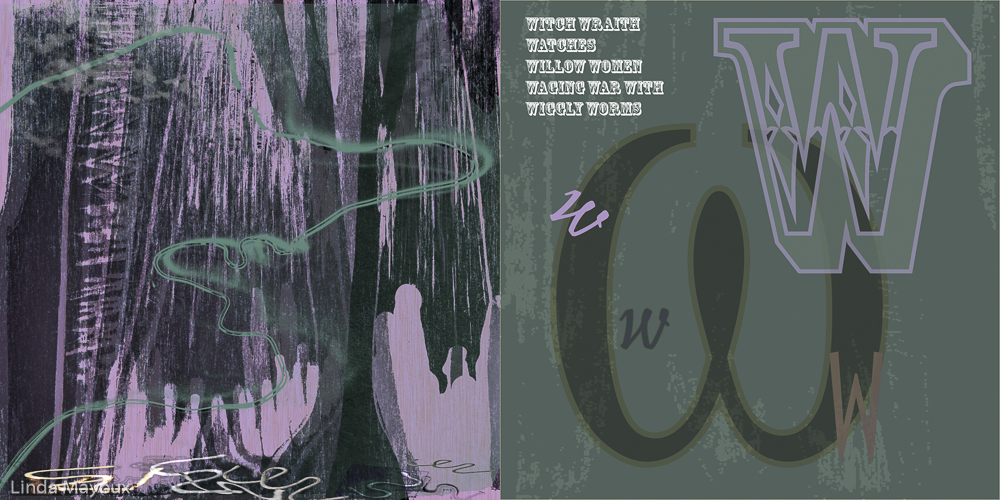NOTE This page needs updating
Witch wraith watches weeping women waging war with wriggly worms
Initial brainstorm sketches
Letter associations
| w | Wax, wax crayon, watercolour, woodcut, wallpaper, water soluble, whiting, wire | Wabi sabi | Warp, wedge, weight | Wheat, White, Wisteria, | washi, watercolour, wax paper, wove paper, wrapping paper, wall paper | Winged werewolves wage water war on woeful wraiths |
First digital mockup
Woodcut willow women
Wire witch
Wool worms
Water wraiths
Research
Fonts




History of the letter
The letter w is a phoneme from German languages that does not occur in Latin and so is not part of the ancient Latin alphabet.
In old English the /w/sound was usually represented by the runic 〈Ƿ〉 wynn. Gothic used a letter based on the Greek Υ for the same sound.
In the 7th or 8th century the earliest writers of Old English and Old High German started to write the phoneme as 〈VV〉 or 〈uu〉 (〈u〉 and 〈v〉 becoming distinct only by the Early Modern period). It is from this 〈uu〉 digraph that the modern name “double U” derives. The digraph was commonly used in the spelling of Old High German, but only sporadically in Old English.
Following the Norman Conquest, 〈uu〉 gained popularity in early Middle English. It was probably considered a separate letter by the 14th century in both Middle English and Middle German orthography,
Scribal realization of the digraph could look like a pair of Vs whose branches crossed in the middle. An obsolete, cursive form found in the nineteenth century in both English and German was in the form of an 〈n〉 whose rightmost branch curved around as in a cursive 〈v〉.
The shift from the digraph 〈VV〉 to the distinct ligature 〈W〉 is thus gradual, and is only apparent in abecedaria, explicit listings of all individual letters, although it remained an outsider not really considered part of the Latin alphabet proper.
English uses 〈w〉 to represent /w/. There are also a number of words beginning with a written 〈w〉 that is silent in most dialects before a (pronounced) 〈r〉, remaining from usage in Old English in which the 〈w〉 was pronounced:wreak, wrap, wreck, wrench, wroth, wrinkle, etc. Certain dialects of Scottish English still distinguish this digraph.
—————————————————————-
To edit from previous post
Mockup
Letter associations
| w | Wax, wax crayon, watercolour, woodcut, wallpaper, water soluble, whiting, wire | Wabi sabi | Warp, wedge, weight | Wheat, White, Wisteria, | washi, watercolour, wax paper, wove paper, wrapping paper, wall paper | Winged werewolves wageing war with woeful wraiths waft wastewater waves windwards |
Research
Letter W in different Typefaces shipped with Adobe.
There are no Typekit fonts that start with W.
Fonts




History of the letter
The letter w is a phoneme from German languages that does not occur in Latin and so is not part of the ancient Latin alphabet.
In old English the /w/sound was usually represented by the runic 〈Ƿ〉 wynn. Gothic used a letter based on the Greek Υ for the same sound.
In the 7th or 8th century the earliest writers of Old English and Old High German started to write the phoneme as 〈VV〉 or 〈uu〉 (〈u〉 and 〈v〉 becoming distinct only by the Early Modern period). It is from this 〈uu〉 digraph that the modern name “double U” derives. The digraph was commonly used in the spelling of Old High German, but only sporadically in Old English.
Following the Norman Conquest, 〈uu〉 gained popularity in early Middle English. It was probably considered a separate letter by the 14th century in both Middle English and Middle German orthography,
Scribal realization of the digraph could look like a pair of Vs whose branches crossed in the middle. An obsolete, cursive form found in the nineteenth century in both English and German was in the form of an 〈n〉 whose rightmost branch curved around as in a cursive 〈v〉.
The shift from the digraph 〈VV〉 to the distinct ligature 〈W〉 is thus gradual, and is only apparent in abecedaria, explicit listings of all individual letters, although it remained an outsider not really considered part of the Latin alphabet proper.
English uses 〈w〉 to represent /w/. There are also a number of words beginning with a written 〈w〉 that is silent in most dialects before a (pronounced) 〈r〉, remaining from usage in Old English in which the 〈w〉 was pronounced:wreak, wrap, wreck, wrench, wroth, wrinkle, etc. Certain dialects of Scottish English still distinguish this digraph.
































